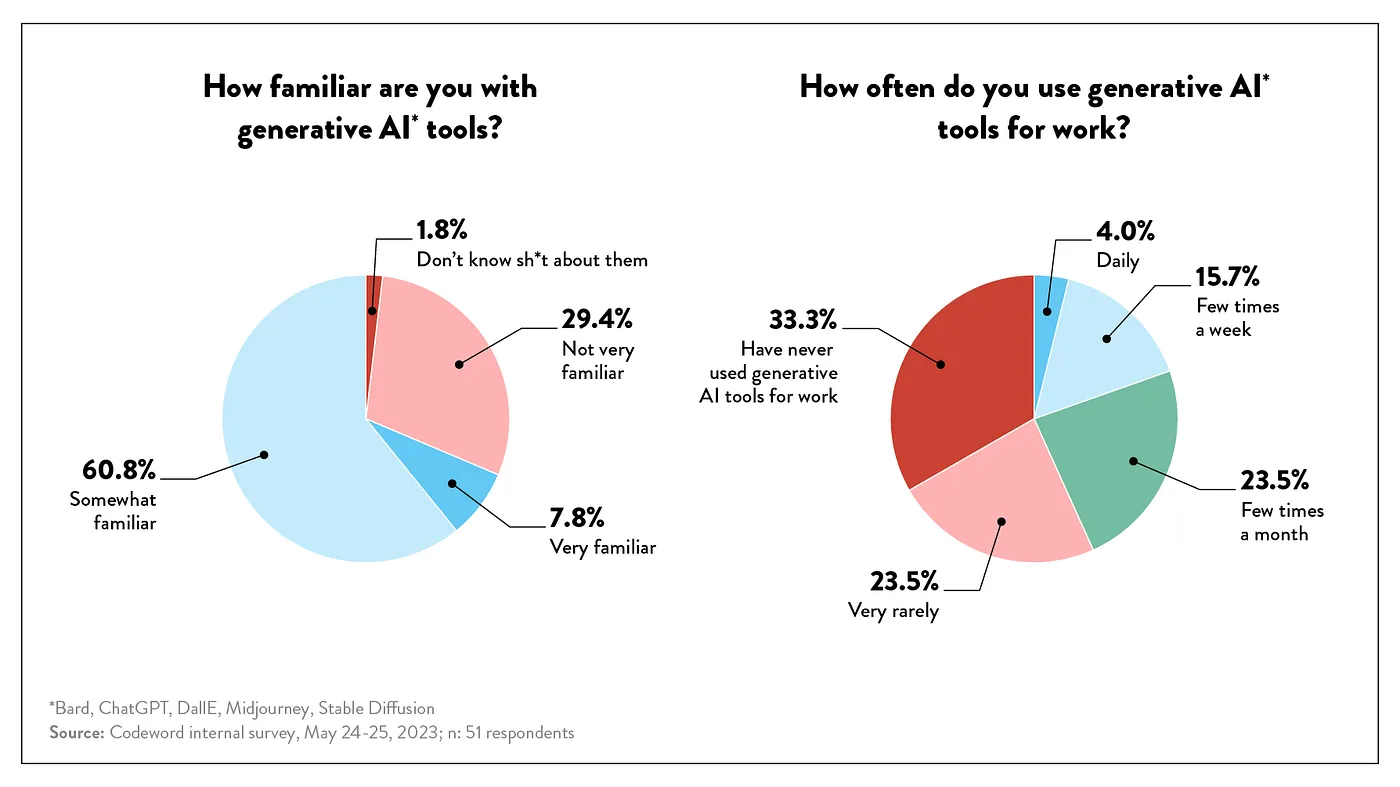It’s been nearly 6 months since we launched our AI internship with Aiden (our “editorial intern”) and Aiko (our “design intern”). You can read our initial announcement here, but in short, Aiden and Aiko were Codeword’s attempt to figure out how generative AI can integrate with our agency creative teams.
We used the gen AI tools themselves to develop names and faces, included Aiden and Aiko in our team directory, and referred to them by name frequently over the past half-year. We even paid them, like all responsible intern programs do. (We’re donating $7,200, the equivalent of two part-time intern salaries, to Anita B, the org that runs Grace Hopper Celebration.)
Our three goals for the program were:
- Figure out what these generative AI tools can do
- Push our team to figure out what they can do with these tools
- Make a little noise and share our learnings with the industry
Now that the program’s wrapping up, let’s see how we did on each, and what we learned…
1. Figure out what these generative AI tools can do
Look, we’re a marketing agency. “Can this tech help us do better work for our clients?” is always top-of-mind when new tools and technologies come out.
If we can save our clients money and do better work for them faster, we have a responsibility to do so. To me, that’s what it means to be their agents. (Agent, agency, same root, you get it.)
With generative AI, there are a number of ways we can do that. Research, gut checks, figuring out best practices, all the formulaic work that requires time but not creativity. The rote work that’s necessary but doesn’t add a ton of real value. Let the robots do that stuff.
For example, in the past few weeks I’ve asked gen AI tools for
- help creating a launch checklist for a campaign
- sample elements for a new client landing page
- revisions to a team note with a more punchy tone
- naming options for a new product
Did I need help with any of that stuff? Nah, I’ve done all those things on my own 100 times. What gen AI gave me was a quick gut-check, filled in a missing piece or two, and then I moved on with my day. Even a few minutes saved here and there make a difference for me.
That seems like the highest-best use for these tools, at least for the foreseeable future, which is why I don’t think we need to be scared about AI replacing creative jobs or creative teams.
Because here’s the thing: Marketing and branding are about standing out and differentiating. Creativity. New ideas that have never been done before. AI isn’t good at that. It can remix and rehash and find the baseline, most formulaic solution to a problem. There’s definitely a use for that in the marketing industry, but it’s not generally what our audiences and clients want from us.
As I said in Campaign a few days ago:
“I’m deeply skeptical that AI will ever be able to create human, differentiated experiences. Coming up with a novel idea that’s never been done before isn’t something AI is good at. It’s also not something most agencies and brands are very good at, which might eventually lead to problems for them. But that’s way down the line.”
Sick burn for a trade pub. And it’s true.
2. Push our team to figure out what they can do with these tools
This goal was tricky. Integrating new tools into a team’s workflow is difficult. Habits change hard, and “maybe this new technology will make your work easier” isn’t a very compelling sales pitch for busy people.
We were hoping by wrapping AI in a clever package with names and faces, we could make the tech feel more approachable, like a team member instead of just another open tab in a cluttered browser. I’m committed to the idea that, as a tech marketing agency, we need to be on the leading edge of agencies with AI expertise, and familiarity with these tools will be a valuable skill for our team members throughout their career.
After 6 months, we have a lot of work to do to further integrate gen AI into our day-to-day work. In a recent internal poll, roughly 69% of Codeword respondents said they are “somewhat familiar” or “very familiar” with generative AI tools. But actual usage varies widely, as you can see below.

I suspect these numbers will skyrocket as Google integrates Bard and other gen AI tools into Google Workspace, the tech backbone of our agency. Until then, actual usage by the team will likely be more split than I was expecting.
And along with pure utilization numbers, we realized we needed to set some guardrails for how the team uses generative AI in our work. Which led us to this collection of general usage guidelines.
Feel free to click through and steal whatever makes sense for your own org.
3. Make a little noise and share our learnings with the industry
We did pretty good here! Codeword is a small agency, we don’t make ad campaigns or play the awards game, so it’s not easy for us to get headlines with trade press, much less the national media. And our little experiment with Aiden and Aiko blew up around the world, with coverage in Axios, ABC News, Campaign, Digiday, Essence, LinkedIn, Morning Brew, AdAge, and lots of others.
It put our agency in front of a whole lot of people who’d never heard of us. Not bad for a creative concept we developed in less than a week with no production budget.
And while the noise is great, this really was an actual initiative with actual learnings for the agency. I expect we’ll have an edge in this space going forward, and that’s what our main goal was.
So thanks for that, Aiden and Aiko, you’ve been great interns. We’re sorry to see you go, but wish you all the best in your new endeavor. Sounds like you’ve already collected a world-class roster of agencies, brands, and partners who want your expertise in bland content generation.
